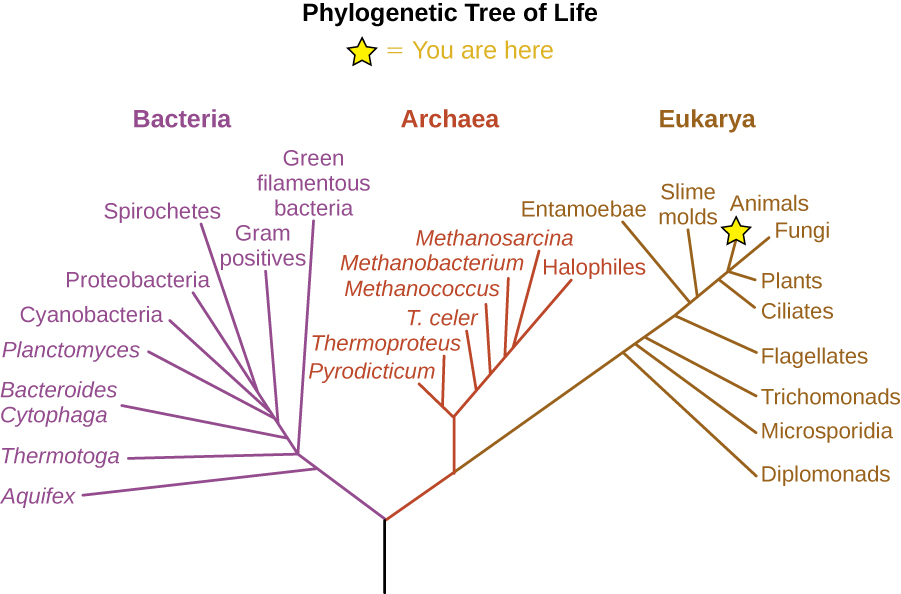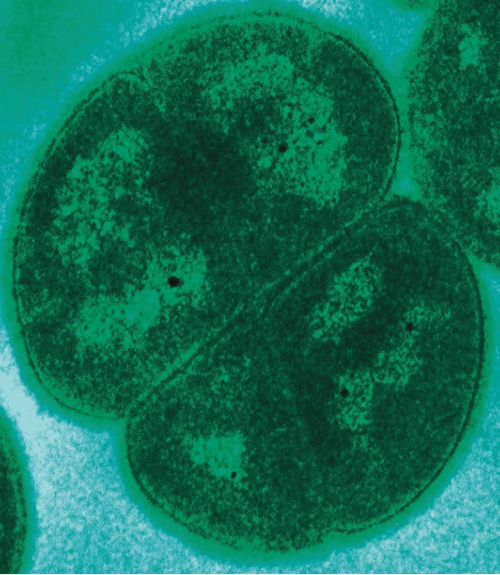37 6.5 “Deep Branching” Bacteria
Learning Objectives
- Describe the unique features of deeply branching bacteria
- Explain the debate about the evolutionary age of the deeply branching bacteria
- Give examples of significant deeply branching bacteria
On a phylogenetic tree (see A Systematic Approach), the trunk or root of the tree represents a common ancient evolutionary ancestor, often called the last universal common ancestor (LUCA), and the branches represent its evolutionary descendants. Scientists have traditionally considered the deeply branching bacteria to represent Earth’s earliest life forms. When placed on the traditional phylogenetic tree, they stem from the common root of life, deep and close to the LUCA root—hence the name “deeply branching” (Figure 6.45).

It has been suggested that the deeply branching bacteria may provide clues regarding the structure and function of ancient and now extinct forms of life. The living ancestors of the deeply branching bacteria are thermophiles or hyperthermophiles, meaning that they thrive at very high temperatures. Thus it has been proposed that those first organisms were also thermophilic and life must therefore have first appeared under hot environmental condition. More recently, however, research has shown that the extremophiles are subject to higher levels of mutation, making the genes used for phylogenetics appear older than they are.[1]
The class Aquificae includes deeply branching bacteria that are adapted to the harshest conditions on our planet. Bacteria from the genus Aquifex are hyperthermophiles, living in hot springs at a temperature higher than 90 °C. The species A. pyrophilus thrives near underwater volcanoes and thermal ocean vents, where the temperature of water (under high pressure) can reach 138 °C. Aquifex bacteria use inorganic substances as nutrients. For example, A. pyrophilus can reduce oxygen, and it is able to reduce nitrogen in anaerobic conditions. They also show a remarkable resistance to ultraviolet light and ionizing radiation. Taken together, these observations have been proposed as support for the hypothesis that the ancient ancestors of deeply branching bacteria began evolving more than 3 billion years ago, when the earth was hot and lacked an atmosphere, exposing the bacteria to nonionizing and ionizing radiation.
The class Thermotogae is represented mostly by hyperthermophilic, as well as some mesophilic (preferring moderate temperatures), anaerobic gram-negative bacteria whose cells are wrapped in a peculiar sheath-like outer membrane called a toga. The thin layer of peptidoglycan in their cell wall has an unusual structure; it contains diaminopimelic acid and D-lysine. These bacteria are able to use a variety of organic substrates and produce molecular hydrogen, which can be used in industry. The class contains several genera, of which the best known is the genus Thermotoga. One species of this genus, T. maritima, lives near the thermal ocean vents and thrives in temperatures of 90 °C; another species, T. subterranea, lives in underground oil reservoirs.
Finally, the deeply branching bacterium Deinococcus radiodurans belongs to a genus whose name is derived from a Greek word meaning terrible berry (Figure 6.46). D. radiodurans is considered a polyextremophile because of its ability to survive under the many different kinds of extreme conditions—extreme heat, drought, vacuum, acidity, and radiation. It owes its name to its ability to withstand doses of ionizing radiation that kill all other known bacteria; this special ability is attributed to some unique mechanisms of DNA repair.

Key Takeaways
- Deeply branching bacteria have traditionally been described as the most ancient forms of life, being the closest to the last universal common ancestor.
- These are all extremophiles which have been recently shown to experience higher rates of mutation than non-extremophiles
- Deeply branching bacteria include many species that thrive in extreme environments that are thought to resemble conditions on earth billions of years ago
Multiple Choice
Fill in the Blank
Short Answer
- Briefly describe the significance of deeply branching bacteria for basic science and for industry.
- What is thought to account for the unique radiation resistance of D. radiodurans?
- S-J. Li et al. "Microbial communities evolve faster in extreme environments". Sci Rep. 4 (2014): 6205. doi: 10.1038/srep06205 ↵
